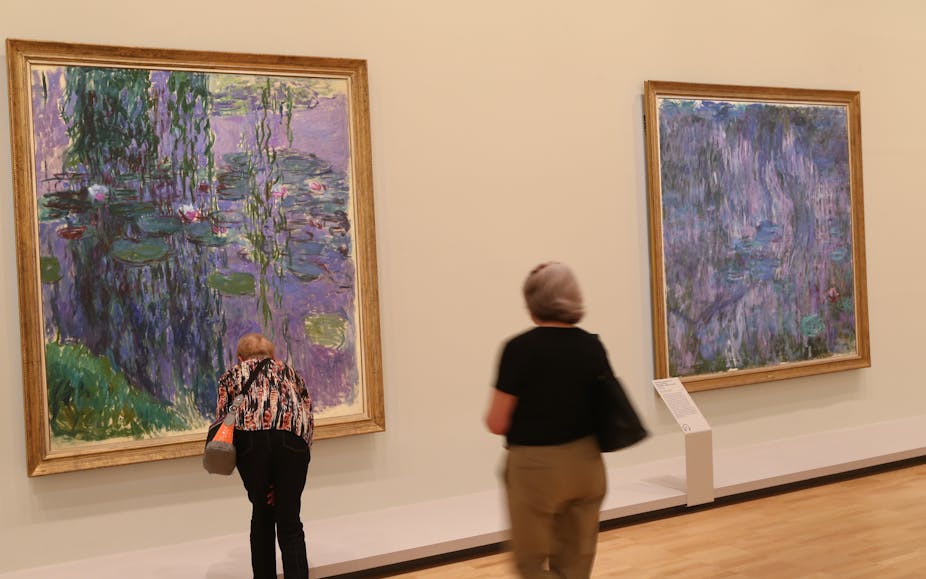As the curtains rise on the National Gallery of Victoria’s (NGV) latest blockbuster, Monet’s Garden, it is a good time to reflect on a connection between this acclaimed modernist painter and the art world of today.
In fact the similarities between how the work of the Impressionists was received bares a striking resemblance to the reception of many contemporary artists. Whilst today’s audience views Monet’s works with reverence, the work of this master and his contemporaries was not always received with such éclat.
Impressionism was an art movement lampooned by cartoonists following their first exhibition. At this time, it was suggested that merely viewing these artworks could cause a pregnant woman to miscarry.

In Monet’s time the art world was committed to the idea that painting should show a fidelity to nature, faithfully depicting a realistic representation of a scene or subject. The critics and public of the day were looking for certainty, resolution, and visual clarity. What they got from the Impressionists was a lack of finish and a sketchy quality that appeared (to the uninitiated) like unfinished work. The Impressionists presented a serious aesthetic challenge to the highly resolved surfaces of classicists like Jean-August-Dominique Ingres and his ilk.

Just as the Impressionists provoked what had come before, so too do today’s artists challenge the Modern art tradition. But with contemporary artists, there is not necessarily a unified movement as was presented by the Impressionists. The global art scene of today is more diverse, including painting and sculpture, but also encompassing digital, multimedia, performing and installation art works.
Many critics of contemporary art think that “Art” ended with the Renaissance, whilst others date its demise to Impressionism. Some key criticisms of contemporary practice centre around its seemingly indecipherable conceptual focus, a perceived lack of skill on the part of the artist, or the aesthetic judgement that the work is no longer “beautiful”. These are almost exactly the same arguments faced by the Impressionists more than a hundred years ago.
Just recently two shows in Australia have seen such criticism, the first Hany Armanious with The Golden Thread and the second Berlinde De Bruyckere with We are all flesh. For many new viewers, these artistic styles are challenging.
According to some reports, the visitors book at Armamnious’ show at the Venice Biennale had more negative comments than positive ones with Australian members of the public writing: “dreadful”, “embarrassed” and “rubbish!”.
In letters to the Adelaide Advertiser, Berlinde de Bruyckere’s sculptures also received similar popular criticism. One concerned member of the public wrote: “I am absolutely appalled and disgusted how this sculpture can be classed as "art”.“ Yet again we see the echoes of a public that struggles with both the finish and categorization of what may be considered as art.

As contemporary art struggles with its relevance in the world today, it has to overcome an inclination to trivialise itself or to entertain the masses, whilst at the same time not becoming so serious that it is irrelevant to a wider audience.
Some suggest that art has ended and that now it is a cultural production like any other consumable item. Others insist that art still fulfils a pivotal role in the development of society, and therefore deserves the lofty position of "Art” with a capital “A”.
Whatever way we look at it, art is a fighting word, especially when you add contemporary into the mix. Whilst it is wonderful to marvel at Monet’s luscious brush strokes and sensibility for capturing light, we must remember that there are also current artists creating equally inspiring and challenging work that will invigorate future generations.
In our visually saturated culture, unprecedented throughout all of human history, art is not a passive process and requires both time and concentration. Much of the imagery we are exposed to demands nothing more of us than our consumption, whereas art demands that we consider alternative points of view. It will take us outside of ourselves, through open windows, where our faculties for thought will be engaged.

There can be no doubt that multitudes will pour through the doors of the NGV to enjoy Monet’s Garden. For these visitors a visual feast awaits. It will not provoke today’s audience as it once did. There is now a well established language that has developed over a century, making these works accessible to a broad and diverse audience.
The hydra that is contemporary art has a journey ahead of it, one that often makes people uncomfortable. And yet, why must we be comfortable? If we do not create space to examine ourselves and our times through art, what will the blockbuster exhibition of the next century present? How will our times be defined?
At certain times in history, creative individuals will appear to challenge the perceptions of the world that we inhabit. The challenge will always be met with criticism by a public that is not yet ready to accept the kind of reality being presented to them.
As the art world becomes much more complex than in the past, comprising of many different ways of making with no affiliation to movements per se, we come to witness the forces that shaped icons like Monet are still very much at play.

